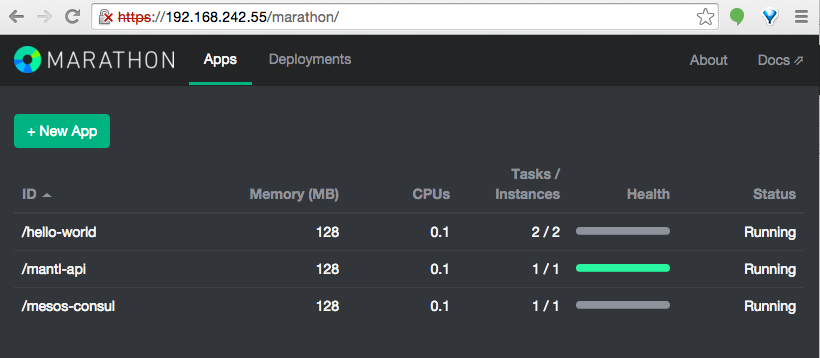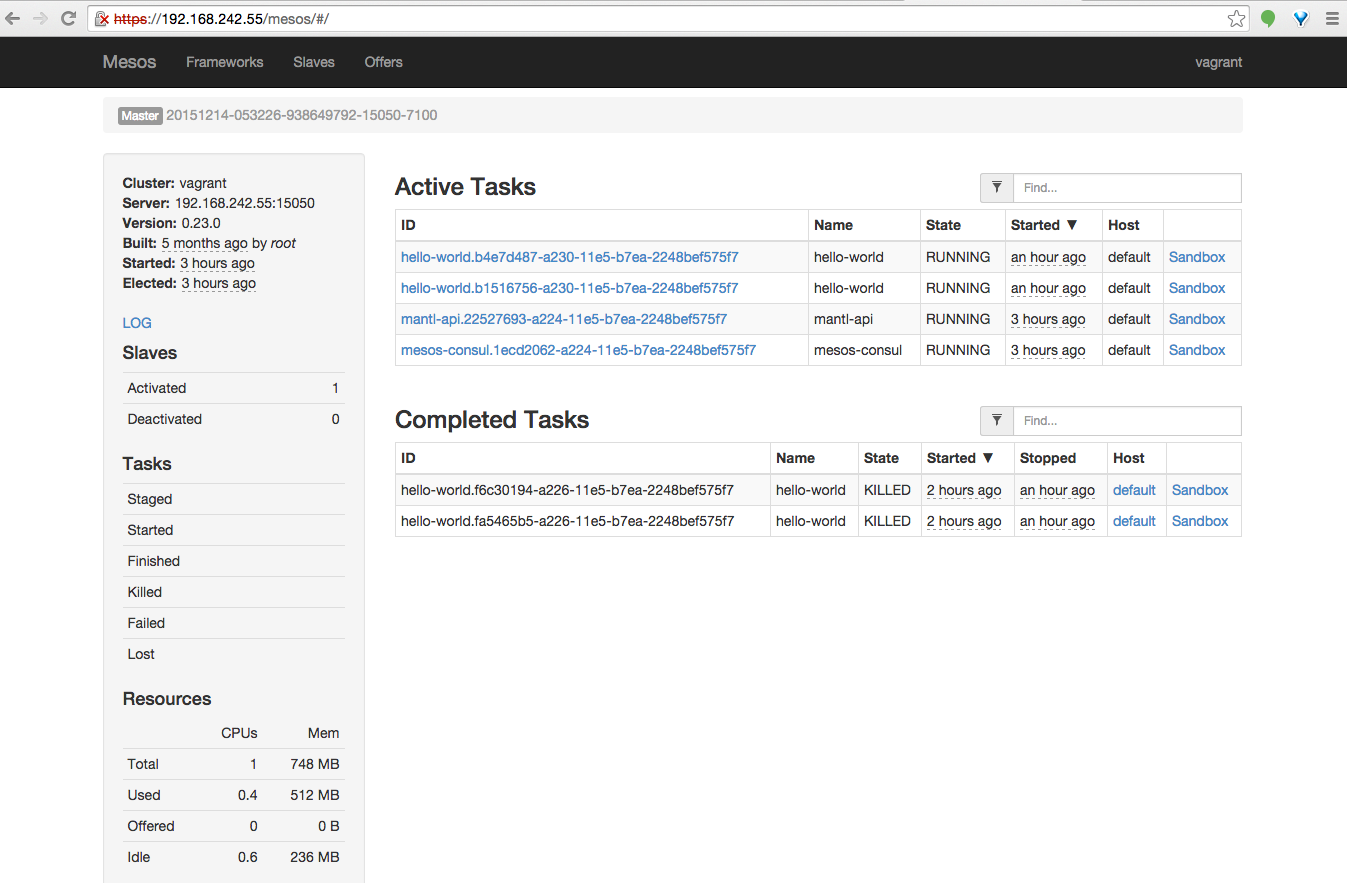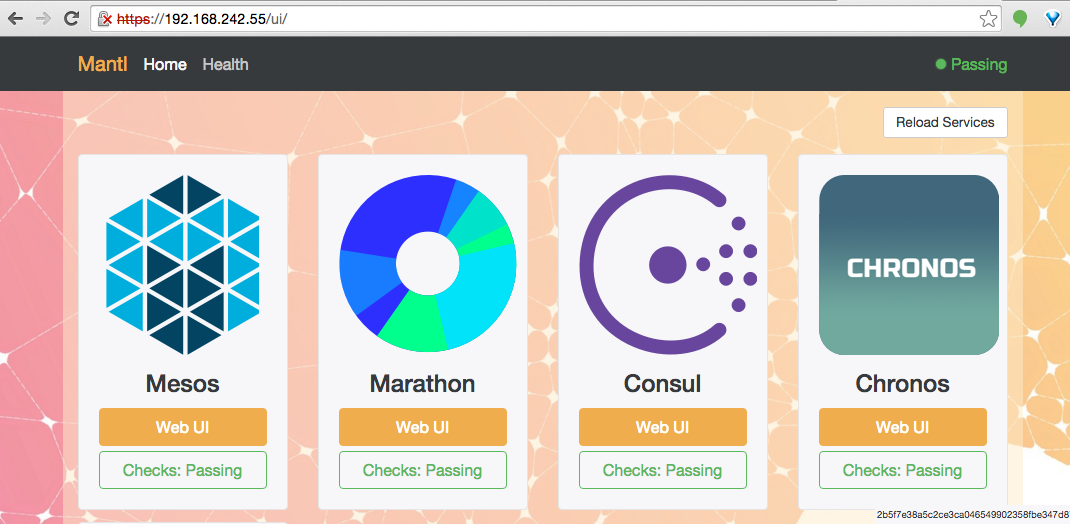The examples in this directory are applications that can be run on your Mantl cluster. See the README.md in each folder for a detailed walkthrough of running them.
Below, we will explore some information that is useful when executing any of the examples, and later, explore some next steps and more advanced usage.
Table of Contents
A local Vagrant cluster is the easiest way to try Mantl. See the Getting Started guide for more information on building your cluster.
See the Getting Started guide for more information on using a cloud provider.
Marathon runs on https://<your-control-ip>:8080 or
https://<your-control-ip>/marathon.
Check out the Vagrant README to figure out the IP addresses it will assign. If you're using the default configuration, you'll have one control node at "192.168.100.101" and one worker at "192.168.100.201".
Run
./plugins/inventory/terraform.py --hostfileto see the IP addresses of your nodes.
During your run of ./security-setup you will be asked to set an admin
password:
$ ./security-setup
============= Certificates =============
----> certificate authority
created serial
created index
generated root CA
================ Nginx =================
----> SSL certificate
generated nginx key
generated nginx CSR
generated nginx certificate
nginx certificate is valid
----> admin password
Admin Password:
which is the password used for Marathon.
If you forgot what you entered, look in security.yml for the line
marathon_http_credentials: admin:<your-marathon-password>
Run the following command from the mantl root directory:
curl -X POST \
-H "Content-Type: application/json" \
--cacert ssl/cacert.pem \
-u "<user>:<pass>" \
-d @examples/<your-app>/<your-app>.json \
"https://<your-control-ip>:8080/v2/apps"It may take a few minutes for Marathon to download the Docker image of your application.
See the "Using curl" section for more details on why we use these options, and "Possible Sticking Points" for some things that can go wrong.
Currently, only the hello-world example can be used with kubernetes. More examples are planned.
Please ensure your cluster has kubeworker nodes before continuing.
Either configure your local installation of kubectl to talk to the kubernetes
API using the instructions in the Kubernetes README,
or ssh into one of your control nodes:
ssh <username>@<your-control-ip>where <username> is generally one of centos, root, or cloud-user.
Then run
kubectl run hello-world --image=nginx
kubectl expose deployment hello-world --type=NodePort --port=8001 --target-port=80This will expose your service on port 8001 on each of your kubeworker nodes.
Note that some browsers may block Mantl's self-signed SSL certificate. If yours does, please try another browser.
Run
curl -s \
--cacert ssl/cacert.pem \
-u "<user>:<pass>" \
"https://<your-control-ip>/marathon/v2/apps/<your-app>" | python -m json.toolYou should get back something like:
{"id":"/<your-app>","cmd":null,"args":null,"user":null,"env":{},"instances":2,"cpus":0.1,"mem":128.0,"disk":0.0,"executor":"","constraints":[],"uris":[],"storeUrls":[],"ports":[0],"requirePorts":false,"backoffFactor":1.15,"container":{"type":"DOCKER","volumes":[],"docker":{"image":"keithchambers/docker-hello-world","network":"BRIDGE","portMappings":[{"containerPort":80,"hostPort":0,"servicePort":0,"protocol":"tcp"}],"privileged":false,"parameters":[],"forcePullImage":false}},"healthChecks":[],"dependencies":[],"upgradeStrategy":{"minimumHealthCapacity":1.0,"maximumOverCapacity":1.0},"labels":{},"acceptedResourceRoles":null,"version":"2015-12-14T05:53:13.140Z","deployments":[{"id":"1b534972-53ee-4198-8860-ea0c48c3d7e9"}],"tasks":[],"tasksStaged":0,"tasksRunning":0,"tasksHealthy":0,"tasksUnhealthy":0,"backoffSeconds":1,"maxLaunchDelaySeconds":3600}Look under "tasks". You should see a host, ID, and port. In your browser,
navigate to http://<host>:<port>.
Open a browser window to the Marathon UI (see the section "IPs and URLs"). To
get information about an app click on the row in the UI. You should see a host,
ID, and port. In your browser, navigate to http://<host>:<port>.
Click on the row for your application, and you'll see something like this:
Your app will have default:<####> under it where <####> is some port number.
In the picture above, these are ports 9061 and 25312.
If you click on the worker-001:9061 it will open your browser to
worker-001:9061 and get a webpage is not avaiable error. This is because you
don't have worker-001 mapped to the node's IP address in your /etc/hosts
file. Rather than mess with that, you can just take the port information and add
it to the IP of your node. Open the browser to <worker-ip>:9061 and you'll see:
While logged into the remote host, or using your customized kubectl command,
run
kubectl describe svc <your-app>Take a look at the field NodePort. You can reach your service by navigating
to http://<your-kubeworker-ip>:<NodePort>, where <your-kubeworker-ip> is the
IP address of one of your kubeworker nodes.
For more information on the options we use, see man curl and the "Using curl"
section further down.
If you forget to provide the --cacert option to curl, you may get a message
like this:
$ curl -X POST -H "Content-Type: application/json" -u "admin:hardpass" -d@"hello-world/hello-world.json" "https://192.168.100.101/marathon/v2/apps"
curl: (60) SSL certificate problem: Invalid certificate chain
More details here: http://curl.haxx.se/docs/sslcerts.html
curl performs SSL certificate verification by default, using a "bundle"
of Certificate Authority (CA) public keys (CA certs). If the default
bundle file isn't adequate, you can specify an alternate file
using the --cacert option.
If this HTTPS server uses a certificate signed by a CA represented in
the bundle, the certificate verification probably failed due to a
problem with the certificate (it might be expired, or the name might
not match the domain name in the URL).
If you'd like to turn off curl's verification of the certificate, use
the -k (or --insecure) option.
If you forgot to provide the -X or -d options to curl, you may get a
message like this:
$ curl -k -H "Content-Type: application/json" -u "admin:hardpass" -d@"hello-world/hello-world.json" "https://192.168.100.101/marathon/v2/apps"
<html>
<head>
<meta http-equiv="Content-Type" content="text/html;charset=ISO-8859-1"/>
<title>Error 400 Bad Content-Type header value: 'application/json '</title>
</head>
<body>
<h2>HTTP ERROR: 400</h2>
<p>Problem accessing /v2/apps. Reason:
<pre> Bad Content-Type header value: 'application/json '</pre></p>
<hr /><i><small>Powered by Jetty://</small></i>
If you remembered both, make sure the path you pass to -d exists.
If you forgot to provide the -H application/json option to curl, you may get
a message like this:
$ curl -k -X POST -u "admin:hardpass" -d@"hello-world/hello-world.json" "https://192.168.100.101/marathon/v2/apps"
curl: (6) Could not resolve host:
{"message":"Unsupported Media Type"}
If your nodes don't have enough resources, the app will be stuck "deploying" in the Marathon UI:
To investigate, go back to the Mantl UI and then navigate to the Mesos "Web UI".
If you don't see any resource offers (on the left hand side), you might have to rebuild your Vagrant cluster with a different configuration. If you have the resources on your computer, you can
- Destroy your vagrant server. Go to the project root and type:
vagrant destroy- Create a
vagrant-config.ymlfile in the root directory, and add
---
worker_memory: 3072
# For running on kubernetes,
# kubeworker_memory: 3072
as documented in the Vagrant README.
- Run
vagrant up
- Go through the example instructions again.
For more information on the commands we use in these examples, see the documentation for the Marathon REST API, kubectl, and curl.
Here are some options we've used with curl, and why we used them:
-X: Use a HTTP verb other than the default GET.--cacert ssl/cacert.pem: Use Mantl's certificate authority to validate your server's SSL/TLS certificate. Since Mantl has self-signed certificates,curl's default bundle will reject them.-u <user>:<pass>: Authenticate with Marathon using the provided username and password.-s: Fromman curl: "Silent or quiet mode. Don't show progress meter or error messages. Makes Curl mute. It will still output the data you ask for, potentially even to the terminal/stdout unless you redirect it."-d @examples/hello-world/hello-world.json: Send the data in that JSON file to Marathon
From this REST API, the call to destroy the application is:
curl -X DELETE \
--cacert ssl/cacert.pem \
-u "<user>:<pass>" \
"https://<your-control-ip>/marathon/v2/apps/<your-app>"Note the similarity with the API call for finding your application.
If the call is successful you will get something like:
{"version":"2015-12-14T06:44:37.378Z","deploymentId":"e7680e8e-d073-4c57-9f64-e73d8b634398"}Now you can check the status again, as per the previous section. It should give
you {"message":"App '/hello-world' does not exist"}.
List your pods with
kubectl get podsand destroy one with
kubectl delete pod <pod-id>Navigating to https://<your-control-ip> will take you to the Mantl UI, from
which you can view all other web UIs.





